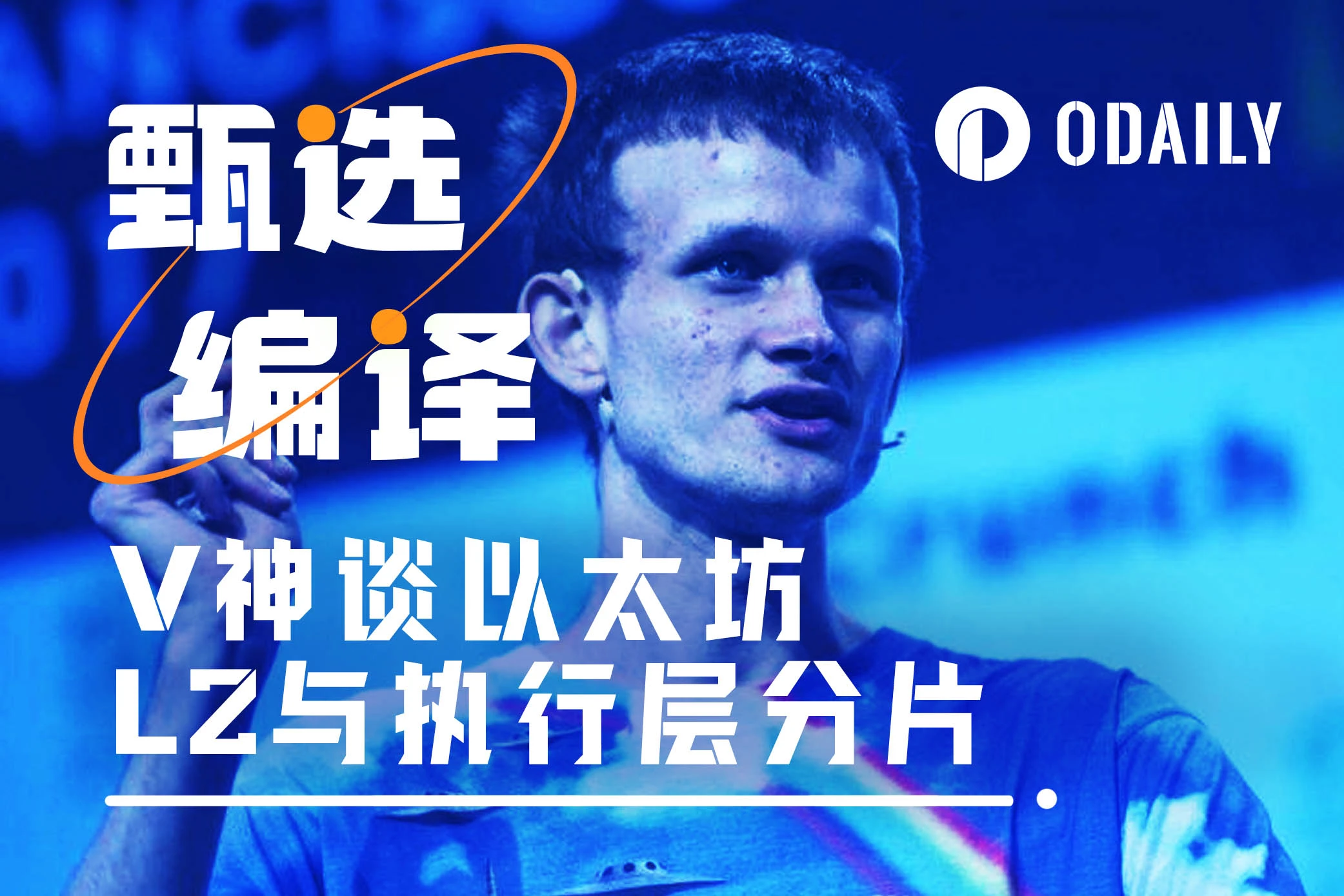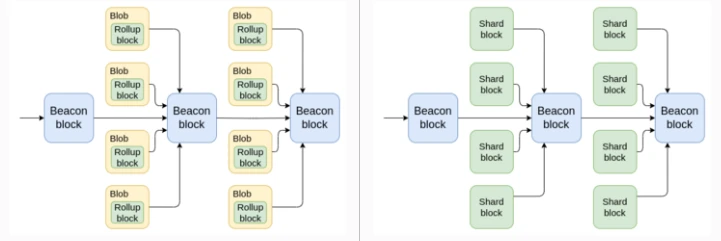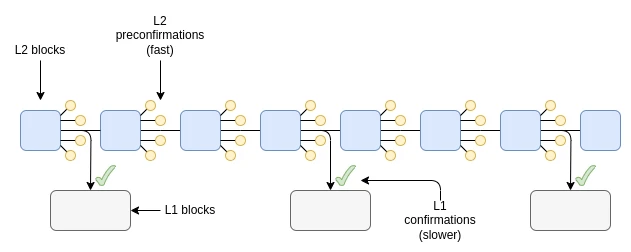Vitalik Buterin'in yeni makalesi: Ethereum L2 ile yürütme katmanı parçalanması arasındaki fark nedir?
Orijinal makale: Katman nasıl yapılır? 2 saniye yürütme parçalanmasından gerçekten farklı mı?
Derleyen: Odaily Planet Daily Asher
İki buçuk yıl önce " Son oyun "Makale şuydu: En azından teknik olarak, blockchain için ileriye dönük farklı yollar çarpıcı biçimde benzer görünüyor.
Her iki durumda da, zincirde çok sayıda işlem vardır ve bu işlemlerin işlenmesi şunları gerektirir: (i) çok fazla hesaplama; (ii) çok fazla veri bant genişliği. 2 TB gibi sıradan Ethereum düğümleri reth arşiv düğümü Bu makaleyi yazmak için kullanılan dizüstü bilgisayarda çalışan, mükemmel yazılım mühendisliği çalışması ve yazılımla bile, bu kadar büyük miktarda veri ve hesaplamayı doğrudan doğrulamak için yeterince güçlü değil Verkle ağaçları Bunun yerine, L1 parçalamada ve toplama merkezli dünya, ZK-SNARK'lar hesaplamayı doğrulamak için kullanılır ve DAS veri kullanılabilirliğini doğrulamak için kullanılır. Her iki durumda da DAS aynıdır ve ZK-SNARK'lar aynı teknolojidir, ancak bir durumda akıllı sözleşme kodudurlar ve diğerinde protokolün kutsal bir işlevidirler. Gerçek teknik anlamda, Ethereum parçalama yapıyor ve rollup'lar parçalama yapıyor.
Bu doğal olarak şu soruyu akla getiriyor: Bu iki dünya arasındaki fark nedir? Cevaplardan biri, kodlama hatalarının sonuçlarının farklı olmasıdır: Toplama dünyasında coin'ler kaybolurken, parçalanmış dünyada fikir birliği başarısızlıkları yaşarsınız.
Ancak protokoller sağlamlaştıkça ve resmi doğrulama teknikleri geliştikçe hataların öneminin azalacağı bekleniyor. Peki bu iki vizyon arasındaki farklar nelerdir ve bunların uzun vadede devam etmesini bekleyebilir miyiz?
Uygulama ortamlarının çeşitliliği
Ethereum'da 2019'da kısaca tartışılan bir fikir şuydu: yürütme ortamları Temelde, Ethereum'un hesapların nasıl çalıştığına (UTXO gibi tamamen farklı yaklaşımlar dahil), sanal makinenin nasıl çalıştığına ve diğer özelliklere ilişkin farklı kurallara sahip olabilecek farklı "bölgeleri" olacaktır.
Bu, yığının çeşitli bölümlerinde yaklaşım çeşitliliğine olanak tanır; Ethereum her şeyi kendi başına yapmaya çalışsaydı bunu başarmak zor olurdu.
Sonunda, daha iddialı planların bazıları terk edildi ve geriye yalnızca EVM kaldı. Ancak, Ethereum L2'nin (rollup'lar, valdium'lar ve Plasmas dahil) nihayetinde bir yürütme ortamı olarak hizmet ettiği söylenebilir.
Günümüzde odak noktası genellikle EVM'nin L2 eşdeğerleri üzerindedir, ancak bu, birçok alternatif yaklaşımın çeşitliliğini göz ardı etmektedir:
-
Arbitrum Kalemi : EVM'ye ikinci bir WASM tabanlı sanal makine ekler;
-
Yakıt : Bitcoin'e benzer (ancak daha kapsamlı) UTXO tabanlı bir mimari kullanır;
-
Aztek : ZK-SNARK'lara dayalı gizliliği koruyan akıllı sözleşmeler etrafında tasarlanmış yeni bir dil ve programlama paradigması sunar.
UTXO tabanlı mimari Kaynak: Yakıt belgesi
EVM'yi tüm olası paradigmaları kapsayan bir süper sanal makine haline getirmeye çalışmak, her bir kavramın uygulanmasını tehlikeye atacaktır ve bu platformların uzmanlaşmasına izin vermek daha iyi olacaktır.
Güvenlik Karşılıklı Ödünleri: Ölçek mi, Hız mı?
Ethereum L1 gerçekten güçlü güvenlik garantileri sağlıyor. Belirli bir veri L1 üzerinde sonlandırılmış bir bloğun içindeyse, tüm mutabakat (aşırı durumlarda sosyal mutabakat da dahil olmak üzere) bu verinin, bu veriyi bloğun içine koyan uygulamanın kurallarını ihlal edecek şekilde düzenlenemeyeceğini, bu veri tarafından tetiklenen herhangi bir yürütmenin geri alınamayacağını ve bu verinin erişilebilir kalmasını sağlamak için çalışır.
Bu garantileri elde etmek için Ethereum L1 yüksek maliyetleri kabul etmeye isteklidir. Yazım sırasında işlem ücretleri nispeten düşüktür: L2 işlemlerinin her biri 1 sentten daha az maliyetlidir ve hatta L1 bile temel bir ETH transferi için $1'den daha az maliyetlidir. Teknoloji yeterince hızlı ilerlerse ve mevcut blok alanının büyümesi talebe ayak uydurursa, bu ücretler gelecekte düşük kalabilir, ancak olmayabilir.
Ve sosyal medya veya oyunlar gibi birçok finansal olmayan uygulama için, işlem başına $0.01 bile çok yüksektir. Ancak sosyal medya ve oyunların L1 ile aynı güvenlik modeline ihtiyacı yoktur. Birinin kaybettiği satranç oyununu bir milyon dolara geri alabilmesi veya tweetlerinizden birini aslında yayınlandıktan üç gün sonra yayınlanmış gibi gösterebilmesi önemli değildir.
Bu nedenle, bu uygulamalar aynı güvenlik maliyetlerini ödememelidir. L2 merkezli yaklaşımlar, bir dizi veri kullanılabilirliği yöntemini destekleyerek bunu mümkün kılar. toplamalar ile plazma ile geçerlilikler .
Farklı L2 tipleri farklı kullanım durumları için uygundur ( Daha fazlasını okumak için buraya tıklayın )
Başka bir güvenlik uzlaşması da şu şekilde ortaya çıkıyor: L2'den L2'ye varlık transferi sorunu Gelecekte (5-10 yıl içinde) tüm toplamaların ZK toplamaları olması ve arama işlevlerine sahip süper verimli kanıt sistemlerinin olması bekleniyor. Binius Ve STARK'ları daire içine alın , bir kanıt toplama katmanıyla birleştirildiğinde, L2'nin her zaman diliminde son durum kökleri sağlamasını mümkün kılacaktır. Ancak şu anda yalnızca çeşitli kanıt zaman pencereleri altında iyimser toplamalar ve ZK toplamalarının karmaşık bir karışımı olabilir.
Yürütme katmanı bölümlendirmesi 2021'de uygulanmış olsaydı, bölümlerin dürüst kalmasını sağlayan güvenlik modeli ZK değil iyimser toplamalar olurdu; bu nedenle L1'in yönetmesi gerekirdi sistemsel olarak karmaşık zincir üzerinde dolandırıcılığa karşı korumalı mantık ve parçalar arasında varlıkları taşırken bir haftalık bir çekilme süresi vardır. Ancak kod hatası gibi, bu sorun da nihayetinde geçiciydi.
İşlem hızı, güvenlik uzlaşmasının üçüncü ve daha kalıcı yönüdür. Ethereum her 12 saniyede bir bloğa sahiptir ve ağı aşırı merkezileştireceği için daha hızlı gitmek konusunda isteksizdir. Ancak, birçok L2 birkaç yüz milisaniyelik blok sürelerini araştırmaktadır.
12 saniye fena değil: İşlem gönderen kullanıcılar, işlemlerinin bir bloğa dahil edilmesi için ortalama 6-7 saniye beklemek zorunda kalıyorlar (sadece 6 saniye değil, çünkü bir sonraki blokta yer almayabilirler). Bu, kredi kartıyla ödeme yaparken beklemeniz gereken zamana benzer. Ancak birçok uygulama daha yüksek hızlar gerektirir ve L2 bunu sağlayabilir.
Bu daha yüksek hızı sağlamak için L2, ön onay mekanizmasına güvenir: L2'nin kendi doğrulayıcıları, işlemi belirli bir zamanda dahil etme vaadini dijital olarak imzalar ve işlem dahil edilmezse cezalandırılırlar. Bahis Eminliği bunu bir adım öteye taşıyor.
L2 Ön Onay
Şimdi bunların hepsini L1'de uygulamaya çalışılabilir. L1, hızlı ön onaylar ve yavaş son onaylar sistemini içerebilir. Farklı güvenlik seviyelerine sahip farklı parçalar içerebilir. Ancak bu, protokolün karmaşıklığını artıracaktır. Ek olarak, tüm işi L1'de yapmak riske girer aşırı yüklenen fikir birliği Çünkü daha büyük ölçek veya daha hızlı verime yönelik birçok yaklaşımın merkezileşme riski daha yüksektir veya daha güçlü yönetim biçimleri gerektirir ve eğer L1'de yapılırsa, bu daha güçlü gereksinimlerin etkisi protokolün diğer bölümlerine de yansıyacaktır. Ethereum, bu dengeleri 2. Katmanda sağlayarak bu risklerden büyük ölçüde kaçınabilir.
Ethereum'un L2 merkezli ekosistemi hangi zorluklarla karşı karşıya?
Ethereum'un L2 merkezli yaklaşımı, L1 merkezli ekosistemlerin neredeyse hiç karşılaşmadığı önemli bir zorlukla karşı karşıyadır: koordinasyon. Başka bir deyişle, Ethereum'un birçok çatalı olsa da, zorluk, Ethereum'un tümünün "Ethereum" gibi hissettirmesi ve N bağımsız zincir yerine Ethereum'un ağ etkilerine sahip olması temel özelliğini korumaktır. Bugün, bu durum birçok açıdan tatmin edici değildir:
-
Jetonları 2. katmandan diğerine taşıma tipik olarak merkezi köprü platformları gerektirir ve ortalama kullanıcı için oldukça karmaşıktır. Optimism'de tokenlarınız varsa, başka birinin Arbitrum adresini cüzdanınıza yapıştırıp onlara para gönderemezsiniz.
-
Zincirler arası akıllı sözleşme cüzdanı desteği hem kişisel akıllı sözleşme cüzdanları hem de kurumsal cüzdanlar (DAO'lar dahil) için pek iyi değil. Bir L2'deki anahtarı değiştirirseniz, diğer her L2'deki anahtarı da değiştirmeniz gerekir.
-
Merkezi olmayan doğrulama altyapısı genellikle eksiktir. Ethereum nihayet düzgün hafif istemciler almaya başlıyor, örneğin: Güneş . Ancak tüm aktivite L2'de gerçekleşiyorsa ve hepsi kendi merkezi RPC'sini gerektiriyorsa bu mantıklı değil. Prensipte, bir Ethereum ana zinciriniz olduğunda L2 için hafif istemciler yapmak zor değil; ancak pratikte buna çok az dikkat edildi.
Üçünü de iyileştirmek için çalışmalar devam ediyor. Zincirler arası token takasları için, ERC-7683 Standart, mevcut "merkezi köprülerin" aksine, sabit bir merkezi operatör, token veya yönetim organına sahip olmayan, ortaya çıkan bir seçenektir.
Zincirler arası hesaplar için çoğu cüzdan, kısa vadede anahtarları güncellemek için zincirler arası tekrarlanabilir bilgileri kullanma yaklaşımını benimser ve anahtar depoları uzun vadede. L2 için hafif istemciler ortaya çıkmaya başlıyor, örneğin Arı Starknet ağı için. Ayrıca, yeni nesil cüzdanlar aracılığıyla kullanıcı deneyimini iyileştirmeye yönelik son çabalar, kullanıcıların artık dapp'lere erişmek için doğru ağa manuel olarak geçmelerine gerek kalmaması gibi bazı daha temel sorunları çözdü.
Rabby, birden fazla zincirdeki varlık bakiyelerinin kapsamlı bir görünümünü sunar (cüzdanların yakın zamana kadar sahip olmadığı bir şey)
Ancak L2 merkezli bir ekosistemin koordinasyon sağlamaya çalışırken bir dereceye kadar yukarı doğru yüzdüğünü kabul etmek önemlidir.
Bireysel L2 kurumlarının koordinasyon için altyapı inşa etmek için doğal bir ekonomik teşviki yoktur: küçük L2 kurumlarının yoktur, çünkü katkılarından yalnızca küçük bir fayda sağlayabilirler; büyük L2 kurumlarının yoktur, çünkü kendi yerel ağ etkilerini güçlendirmekten en az onlar kadar veya daha fazla fayda sağlayabilirler.
Bu soruna sihirli ve mükemmel bir çözüm varmış gibi değil. Sadece ekosistemin, çapraz L2 altyapısının, tıpkı L1 istemcileri, geliştirme araçları ve programlama dilleri gibi bir tür Ethereum altyapısı olduğunu ve değerlendirilmesi ve finanse edilmesi gerektiğini daha iyi anlaması gerekiyor. Şu anda, Protokol Loncası ve belki de Temel Altyapı Loncası.
özet
Kamusal tartışmalarda, Ethereum L2 ve yürütme katmanı parçalama genellikle blok zincirlerinin nasıl ölçekleneceğine dair iki zıt strateji olarak tanımlanıyor. Ancak, altta yatan teknolojiye bakıldığında bir bilmece ortaya çıkıyor: gerçekte altta yatan ölçekleme yöntemleri tam olarak aynı, temel fark şudur: İlgili bileşenlerin oluşturulması ve güncellenmesinden kim sorumludur ve ne kadar özerkliğe sahiptirler?
Ethereum L2 merkezli ekosistem, gerçek teknik anlamda sharding'dir, ancak sharding içinde kendi kurallarınızla kendi shard'ınızı yaratabilirsiniz. Bu yaklaşım çok güçlüdür ve çok fazla yaratıcılık ve otonom inovasyona izin verir. Ancak aynı zamanda özellikle koordinasyon açısından bazı temel zorluklar da sunar.
Ethereum gibi L2 merkezli bir ekosistemin başarılı olabilmesi için bu zorlukları anlaması ve bunları doğrudan ele alarak L1 merkezli bir ekosistemden mümkün olduğunca çok fayda elde etmesi ve her iki dünyanın da en iyisine mümkün olduğunca yaklaşması gerekir.
Bu makale internetten alınmıştır: Vitalik Buterin'in yeni makalesi: Ethereum L2 ile yürütme katmanı parçalanması arasındaki fark nedir?
Kaynak: CapitalismLab Aerdromes fiyatı bir turdan geçti ve Base, kaslarını göstererek tek başına 1 milyar Mcap, 2 milyar FDV, yüz kat coin zirvesini destekledi. Getirdiği olumlu dışsallıklar da Base ekosistemini daha da canlandırdı. Öte yandan, BSC bu turda ayakkabı düştükten sonra bile herhangi bir ilerleme kaydetmedi. Boşluk nerede? Bu konu, bu turda zincirdeki iki CEX arasındaki boşluğu tartışmak ve yorumlamak için bunu bir başlangıç noktası olarak kullanacak. Coinbase'in Aero'yu çekmesinin nedeni çok basit. Aşağıdaki şekilde gösterildiği gibi, geçmişte projeler DeFi madencilerine doğrudan teşvikler sağladı. Örneğin, $2 değerinde bir proje belirteci için, bir madenci DEX'ten ek $1 alabilirdi…













